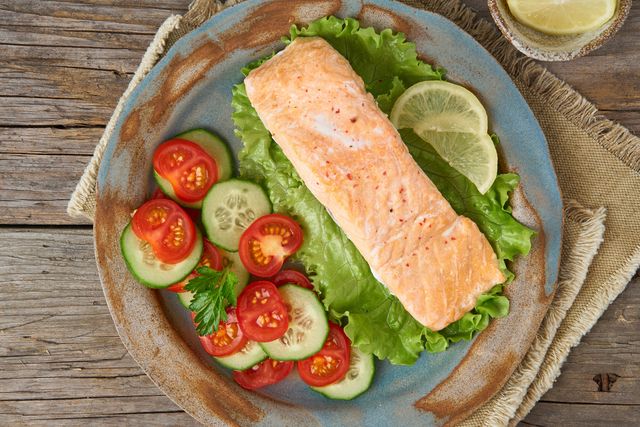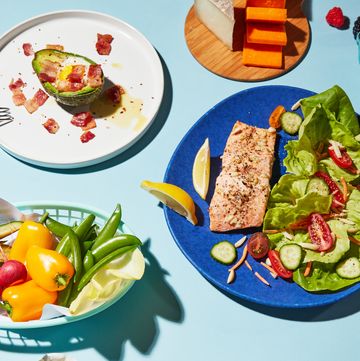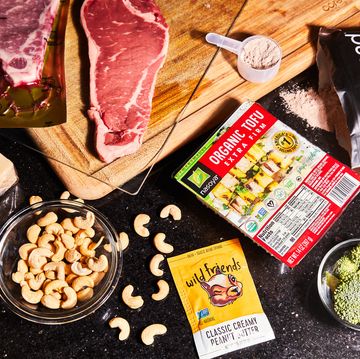If gastrointestinal issues keep you from enjoying your miles or the celebrations afterward, know you’re not alone. According to a 2017 study, 84 percent of male runners and 78 percent of female runners experience at least one GI symptom each month.
Of course, the causes for GI issues can vary widely from person to person, but one small study points out that following a certain eating plan—known as the low FODMAP diet—can potentially help alleviate symptoms such as cramps and bloating. According to researchers, cutting out foods that contain a high amount of FODMAPs (a type of carb) could reduce water volume and gas production in the gut.
What Is the Low FODMAP Diet?
FODMAP stands for fermentable oligosaccharides, disaccharides, monosaccharides, and polyols, thus a low FODMAP diet is a way of eating that limits FODMAP foods. “These foods have a type of carb or sugar that ferments in the colon,” says Ginger Hultin, R.D.N., spokesperson for the Academy of Nutrition and Dietetics and founder of Champagne Nutrition. “For most people [this type of food] doesn’t bother them at all—it’s part of healthy digestive system. But for people who do have a GI situation, they might notice more gas or bloating.”
People with irritable bowel syndrome (or IBS), for instance, tend to feel better when they limit FODMAPs, as research shows it can reduce symptoms. But cutting out FODMAP foods can become pretty restrictive—it requires limiting everything from onions and mushrooms to blackberries, apples, cauliflower, snow peas, as well as lactose and gluten. (Yep, it’s a long list of foods on the “no” list.)
Should I Try the Low FODMAP Diet?
Following an eating plan like the low FODMAP diet isn’t something you necessarily want to jump right into, says Hultin. “I think the first thing people should do if they’re considering the low FODMAP diet is meet with a sports dietitian or doctor to see if they’re fueling properly in the first place,” she says. “Then maybe you don’t have to worry about following some sort of diet.”
A doctor can also test to see if there are any underlying conditions, like irritable bowel syndrome or inflammatory bowel disease, diabetes, or bacterial overgrowth, says Hultin.
Also, the low FODMAP diet isn’t meant to be a long-term solution, says Hultin. It’s meant to help you figure out what leads to these uncomfortable stomach symptoms, so you can cut back on only those foods, not whole food groups. In fact, while studies do show the benefits of a low FODMAP diet (particularly for those with IBS), researchers still point out the need for long-term studies.
“People shouldn’t be on [a low FODMAP diet] for more than one to two months at the most,” says Hultin. After a few weeks of eliminating all high-FODMAP foods, you slowly reintroduce them to figure out the culprit of your GI disruption, rather than sticking to the long list of restrictions.
It’s also important to note that symptoms tend to alleviate in those with IBS after three to eight weeks. In the recent exercise-specific study from the UK, subjects only tried the diet for a week. So it’s tough to tell how it would go if they continued following the restrictions for a longer time period.
What Else Can I Do If I Don’t Try the FODMAP Diet?
Pamela Nisevich Bede, R.D., a sports dietitian with Swim, Bike, Run, Eat agrees that most runners simply make poor choices prerun or even during a run that lead to bathroom breaks. “Before a run, high-fat items, spicy items, and fibrous items can wreak havoc on the GI system,” she says. “Fiber and fat take longer to digest compared to quick carbs and this longer digestive transit can result in cramps, feelings of fullness and discomfort, as well as runners’ trots.”
During a run, some people also tend to fill up on too much food or fluids. You need to replenish glycogen when you’re running longer than 75 minutes, Bede says, doing so with about 30 to 60 grams of carbs. “Any more than this, and it doesn’t energize you and could mean your stomach won’t agree with gels, chews, and sports drinks,” she warns. “The gut can only process approximately one gram of carb per minute and too much carb will just sit and fester.”
What’s more, if your source of fuel is super concentrated, your body has trouble absorbing it, and then pulls water from surrounding tissues to dilute it. “Make it a goal to start with 30 grams of carbs an hour and assess tolerance,” Bede suggests. “Then chase the fuel with water to dilute it and help it move from your gut to working tissues.”
Limiting caffeine intake and avoiding fluids at least 15 minutes before you run can also put a pause on GI pit stops.
[Build a killer midsection in the kitchen for powerful, effortless miles on the road with Eat for Abs.]
What Precautions Should I Take If I Do Try It?
“If you’re getting a nutrient-dense diet and including gut-friendly foods throughout the day, and you’re timing the food intake correctly, yet still struggling with GI issues, moving to a low FODMAP diet can be a logical next step,” says Bede.
When you’re ready for it, call in an expert who can help you understand your symptoms and help you identify the foods that bother you, says Bede who cautions that this diet can be complex and confusing, so a knowledgeable navigator is super beneficial. You don’t want to just embark on it without guidance.
“I think removing foods that ail you is always a good strategy—but you have to figure out what those foods are first,” she says. Also, if you currently rely on a lot of these FODMAP foods to fuel your runs, you have to make sure you’re finding another way to fill up. That way you don’t hit that dreaded mid-mileage bonk.
Hultin adds a final caution on jumping into the low FODMAP diet and eliminating foods that push you through your workouts: “The low FODMAP diet cuts out wheat and rye, and a lot of different fruits, but those are really awesome fuel for runners, as is yogurt and milk or chocolate milk. If you’re a vegetarian or vegan runner, you’re removing important protein sources, too,” she says. “The bottom line is that it is a restrictive diet and it does remove nutrients that are important for runners. I wouldn’t take the decision to do this diet lightly; it’s a big decision.”
The bottom line: Don’t make the low FODMAP diet your first line of defense against stomach issues. While it can improve GI distress in some, you should only turn to it when you’ve exhausted other options, and with the guidance of an expert or professional.













